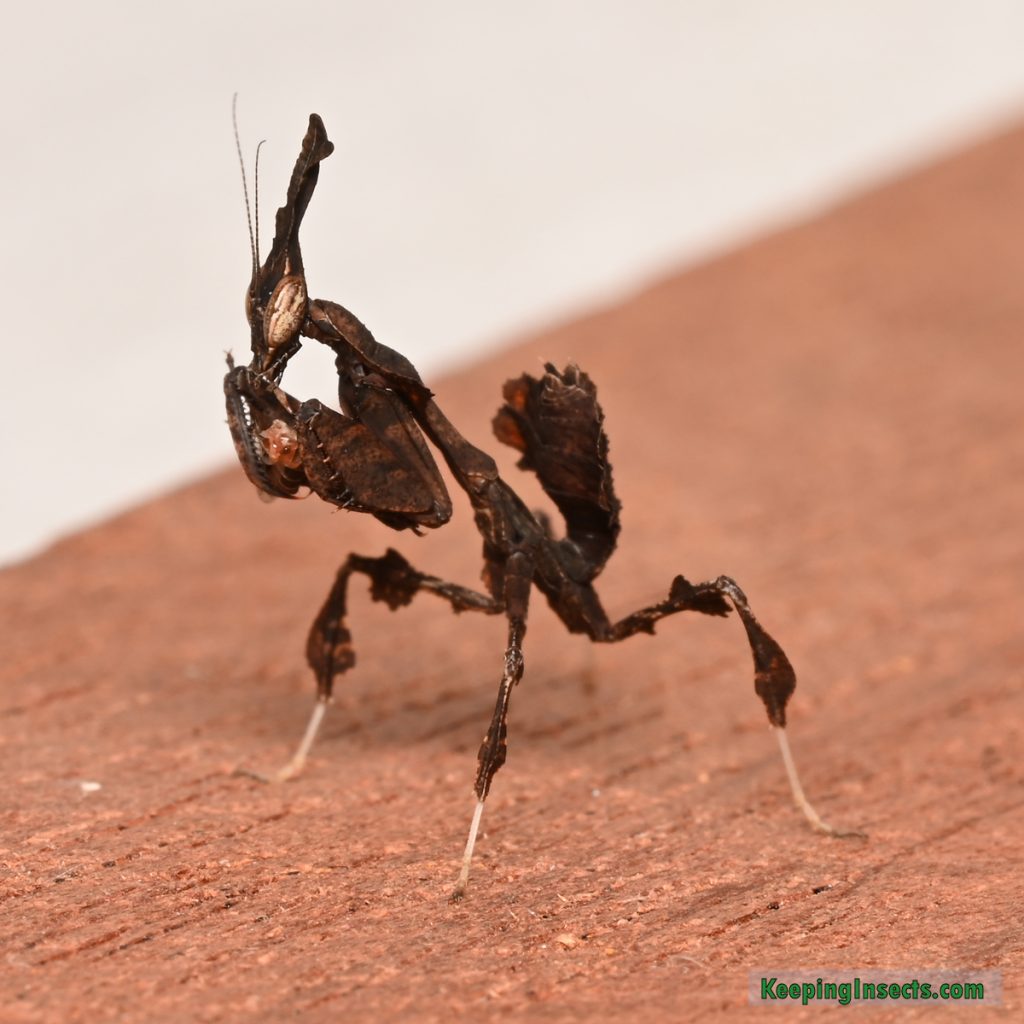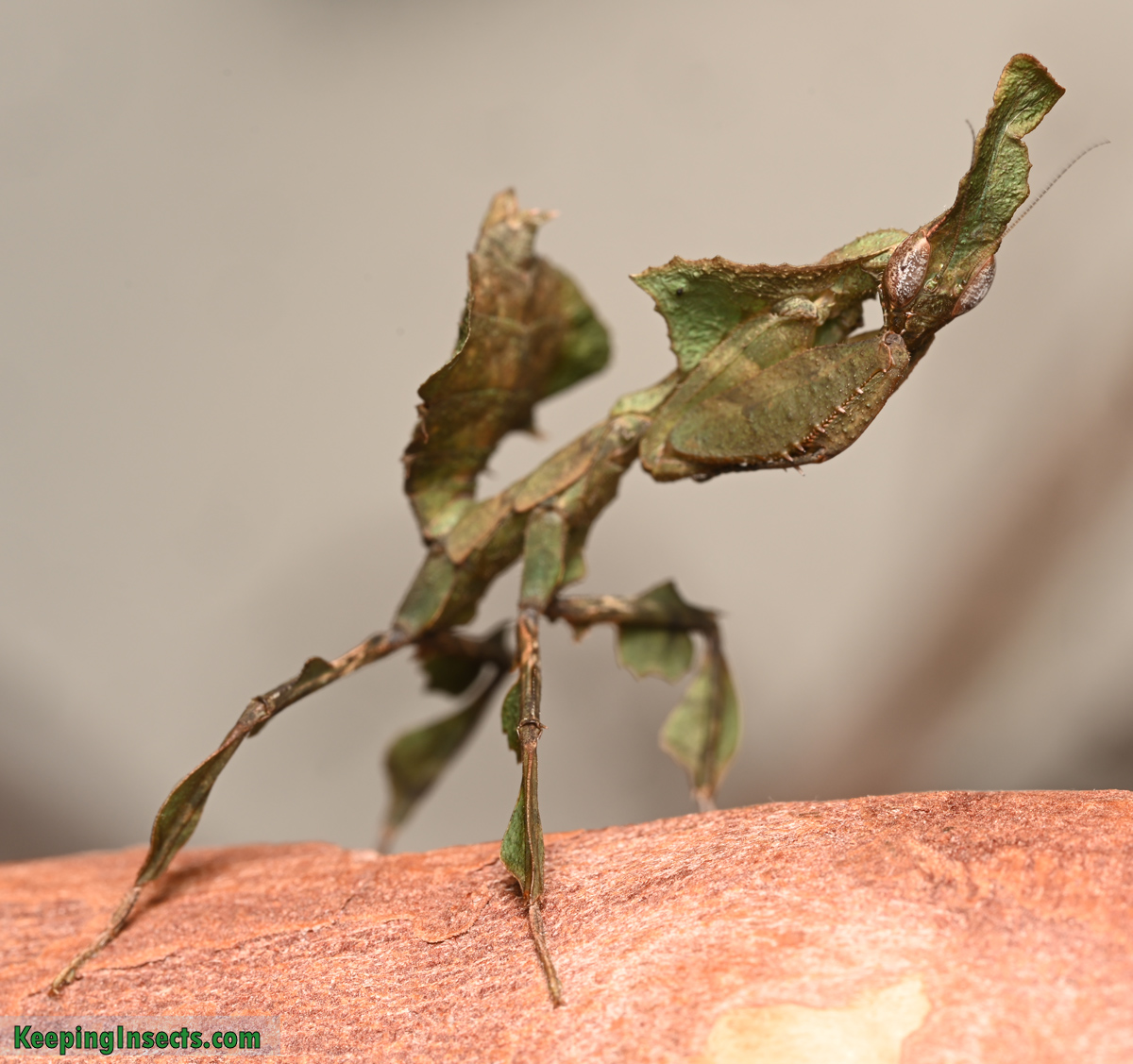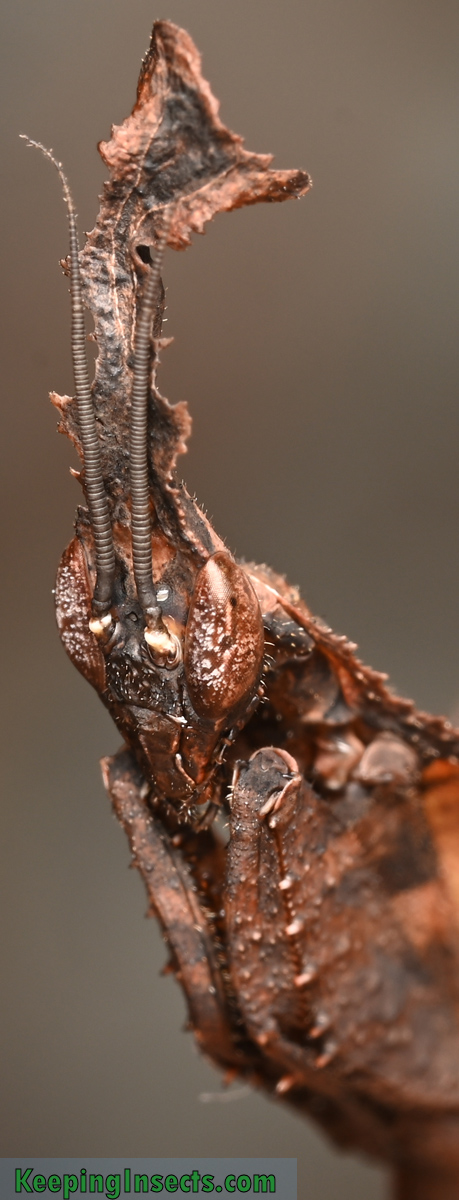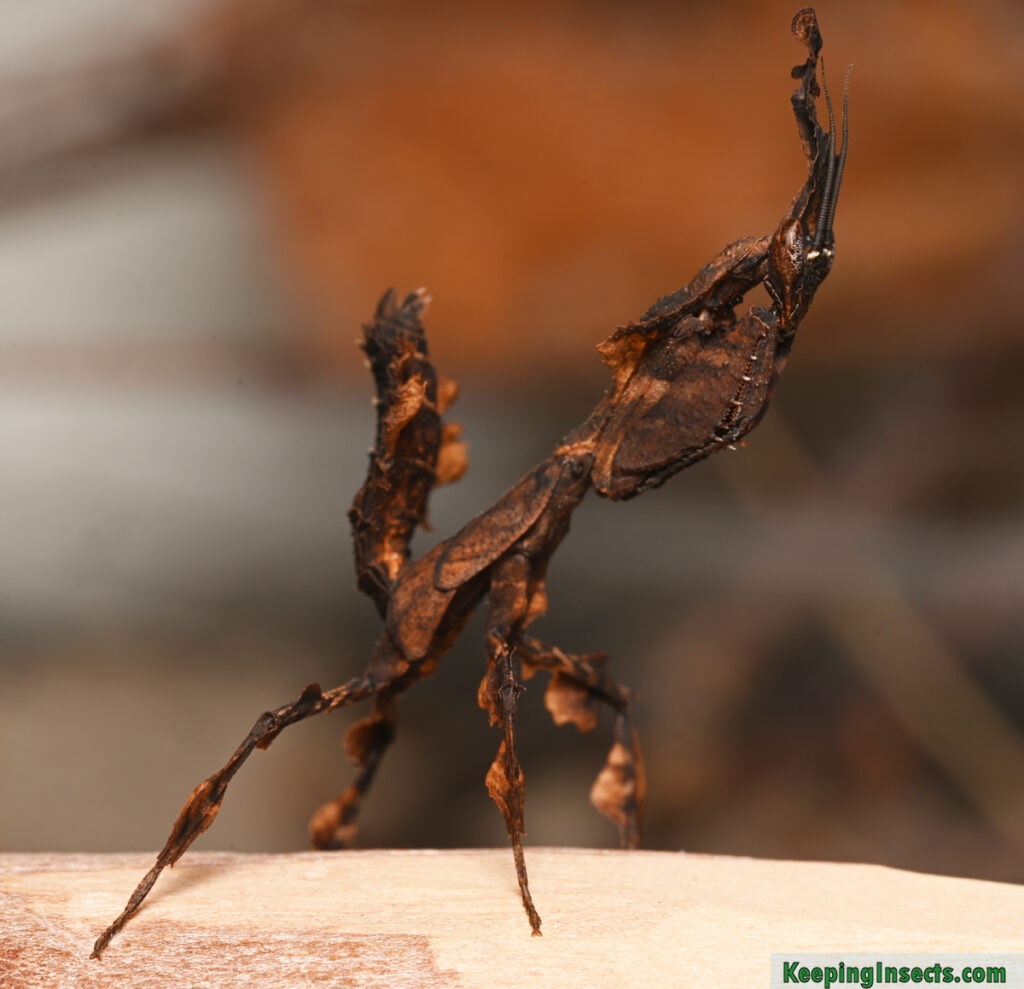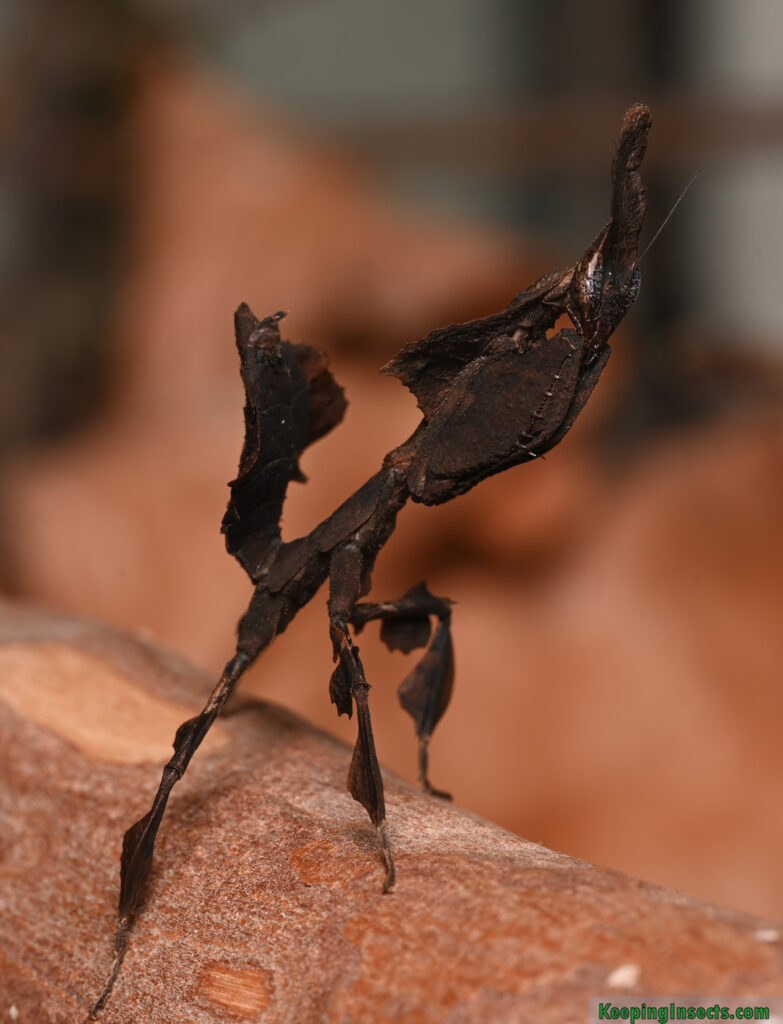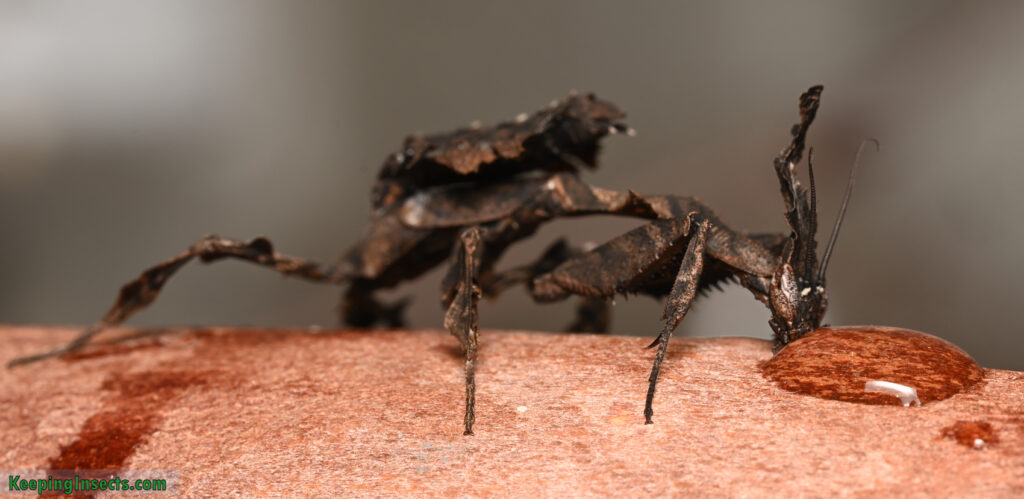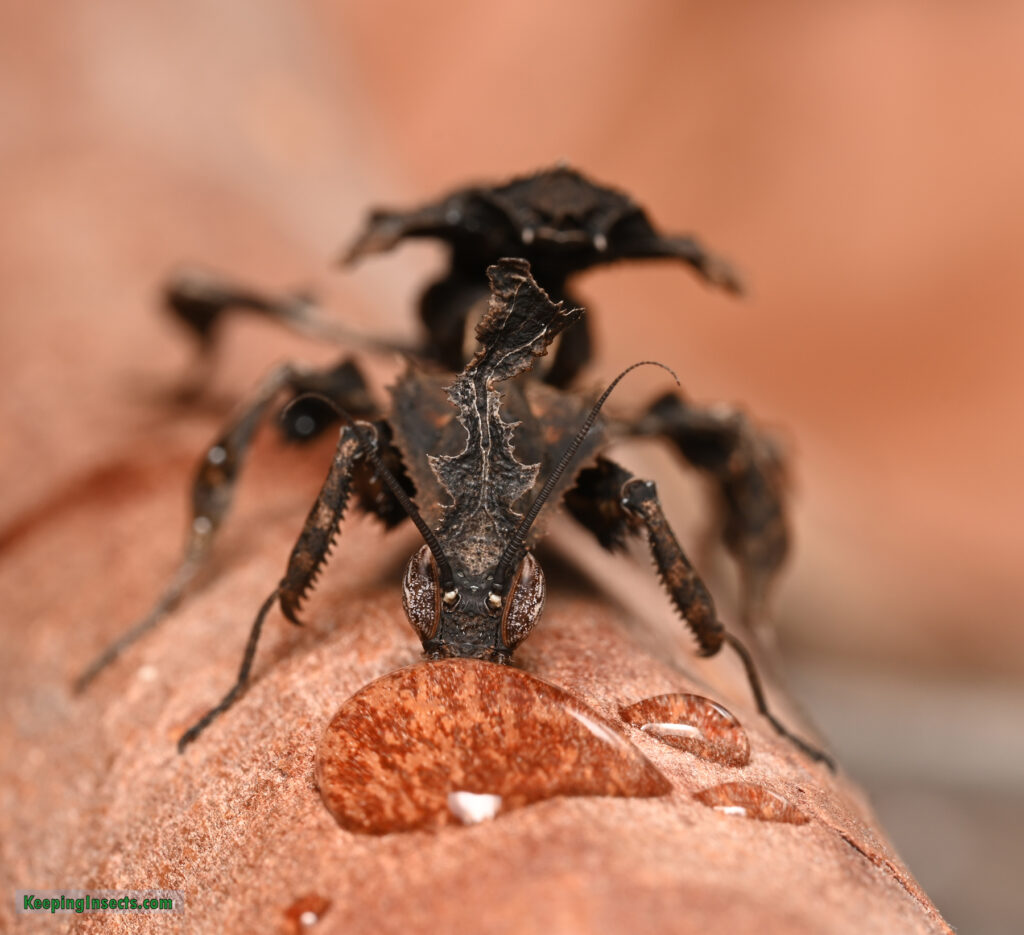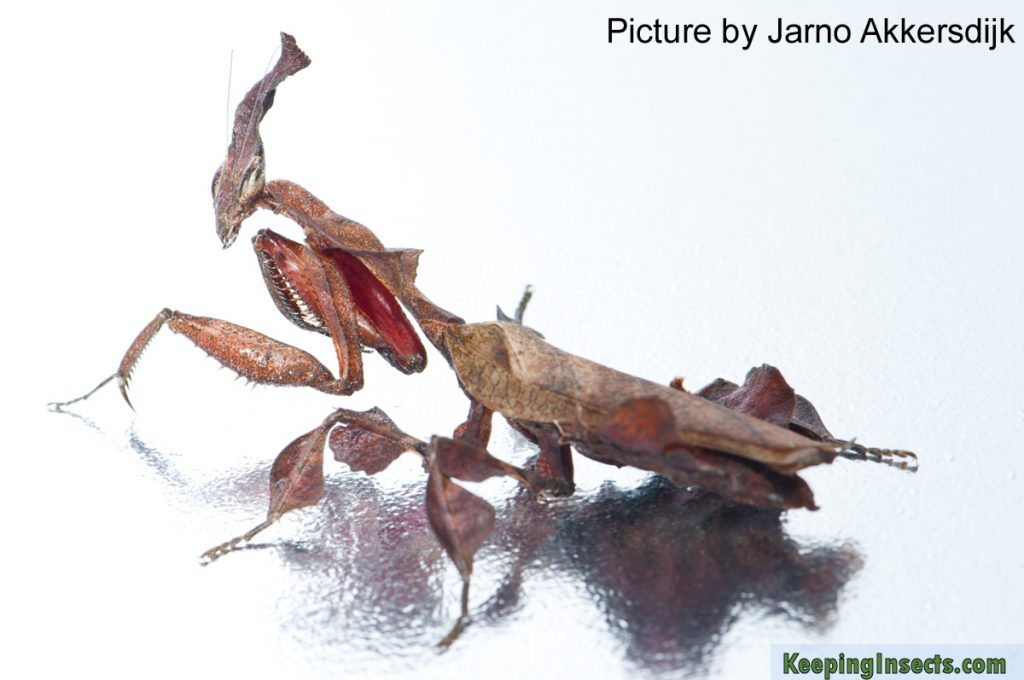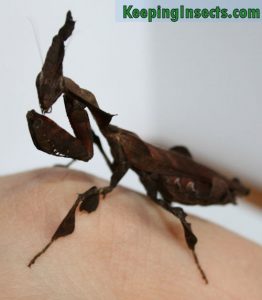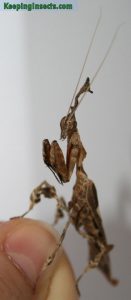The Ghost mantis, also known as Phyllocrania paradoxa, is a species that has a beautiful leaf-like body. It’s color is usually dark brown, but can also be sand, light brown or even green. The natural habitat of the Ghost mantis is Madagascar and continental Africa. To learn more about keeping this mantis as a pet, continue reading this caresheet below.
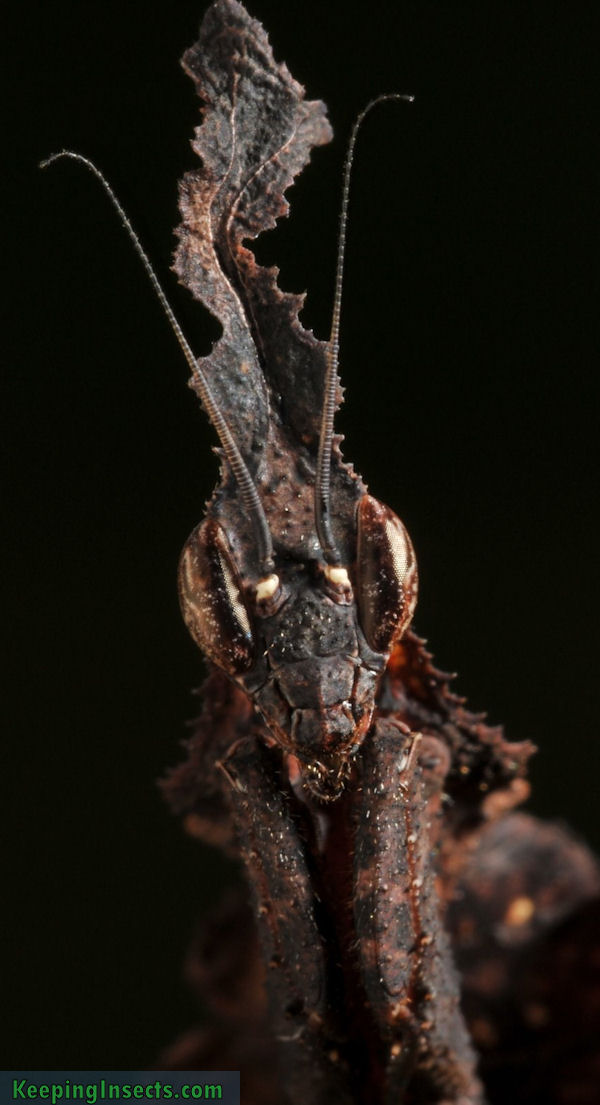
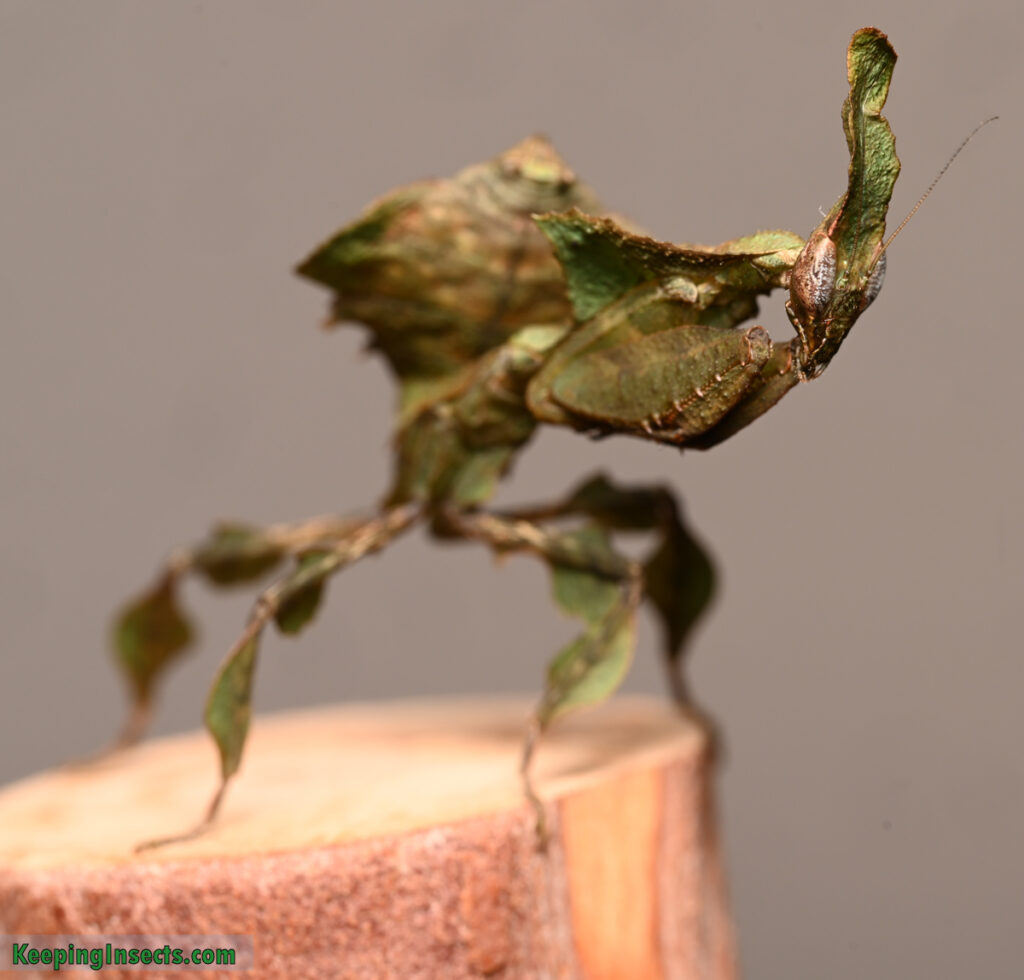
Appearance of the Ghost Mantis
The Ghost mantis Phyllocrania paradoxa mimics withered leaves by its dark body covered in leaf-like decorations. On its head it has a striking asymmetrical cone or crest that helps to distort its body outline to look more like a leaf. In this way it is camouflaged among the fallen leaves in its natural habitat; the forest of Madagascar and Africa. They can remain unseen by predator such as insect-eating birds while waiting for its own prey. The most common color for this praying mantis species is dark brown, but sometimes you can find light brown, reddish brown or even green specimens. The color of the skin is determined by the environment, a more humid environment provides a greener individual, but some are more predispositioned to change color than others.
Phyllocrania paradoxa is about 5 cm long when adult, with little difference in bodysize between the sexes. The males weight much less than the females. The males are thinner with long wings that reach past the abdomen. The females are bigger and bulkier than the males. They also have a wider prothorax and their wings extend to just the end of the abdomen, not further. The antennae of the adult male are much longer than those of the female. The difference between the sexes can also be seen when still in the older nymph stadia, because males have a more indented extension on the head. The males body has also more jaggedy edges than the female.
The males develop a bit faster than the females and will need 6 molts instead of 7. When born their instar is named L1, so the males will be adult at L7 and the females at L8. When adult both sexes will have wings, before they are adult they are wingless.
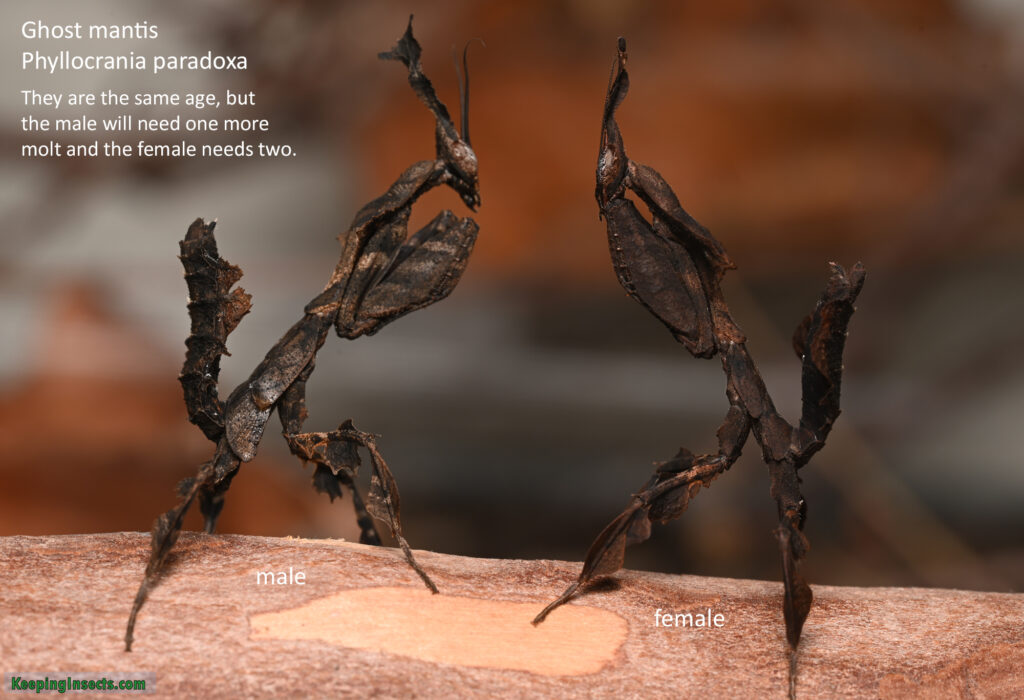
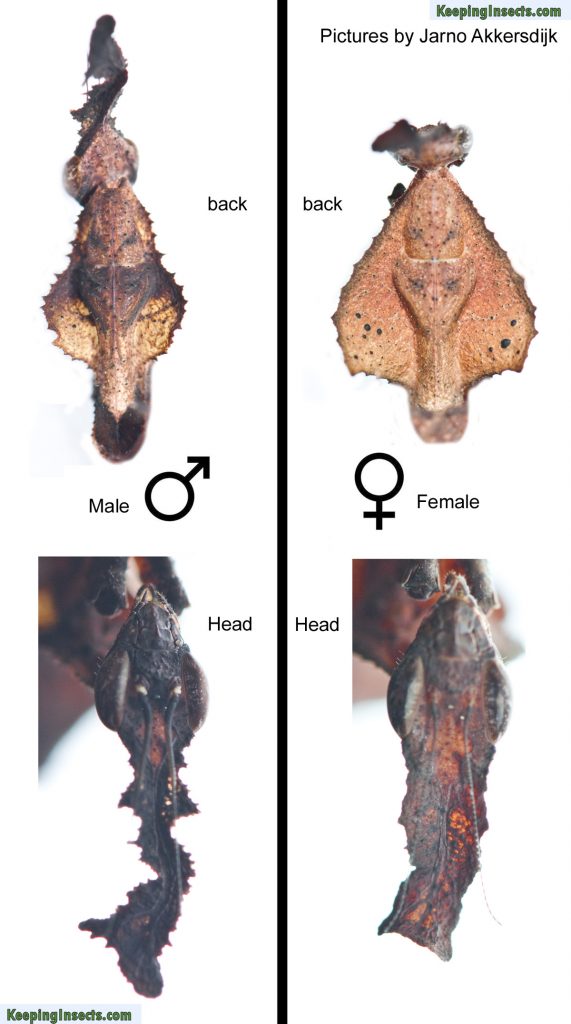
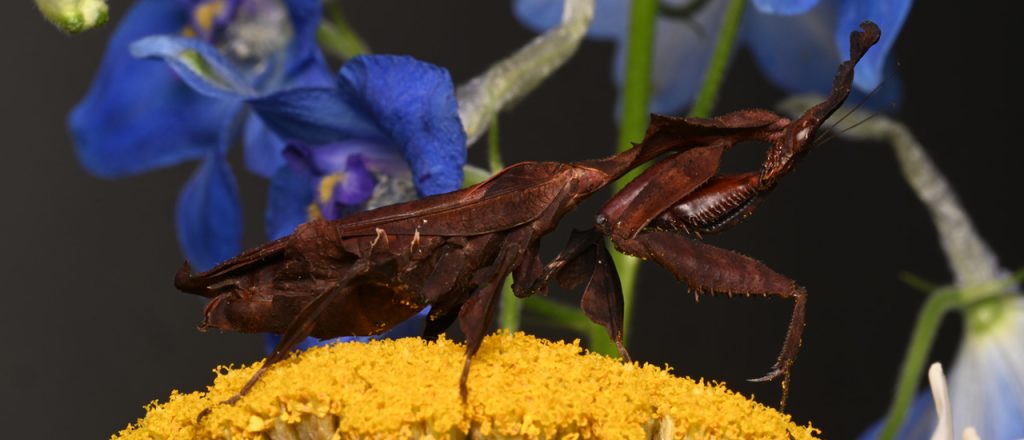
Behavior of the Ghost mantis
The Ghost mantis is a quiet kind of praying mantis. It is a typical sit-and-wait predator. Relying on her camouflage it waits patiently until an unsuspecting prey comes along. Once she sees her prey, she will attack very fast. Before the prey realizes it, he is already firmly stuck between the claws of this predator. P. paradoxa will rarely actively chase its prey, it will rather wait for an opportune moment to strike. It is specialized in flying prey and prefers to eat flies.
Sometimes this kind of praying mantis is a little scared and easily intimidated by its prey. Especially the adult males can run away from large prey instead of attacking. Also large tweezers or the hand of the owner can make this mantis refuse its prey. When this happens during feeding, just wait fifteen minutes and try again.
Because they are less agressive and prefer to eat flies, ghost mantises will not be as likely to eat each other. So unlike other mantis species ghost mantises can be housed together in one enclosure. See below for more details about this.
Newborn ghost mantises look like black ants and behave in the same way. They run around a lot. When they change skin for the first time they are no longer black, but brown, will look like leaves and will not move as much anymore. Adult males can be easily scared and can fake being dead if disturbed.
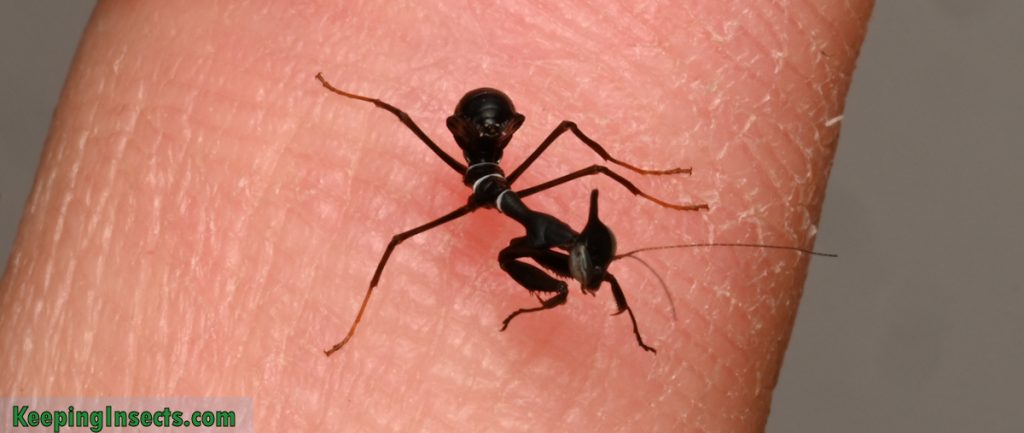
Food for a Ghost Mantis
In nature, Phyllocrania paradoxa mainly eats flying prey such as flies. Therefore it should be prefered to feed flies instead of crickets to Ghost mantids. But this species of mantis also feeds well on crickets, small grasshoppers and other insects. The size of its prey should be approximately the size of the head of the mantis. This species is not as strong as some other species, making it less fit to catch very large prey items. An adult female can eat adult crickets without a problem, but I prefer to feed them smaller grasshoppers or flies. Newborn ghost mantises will eat fruit flies, either the smaller or the bigger variety.
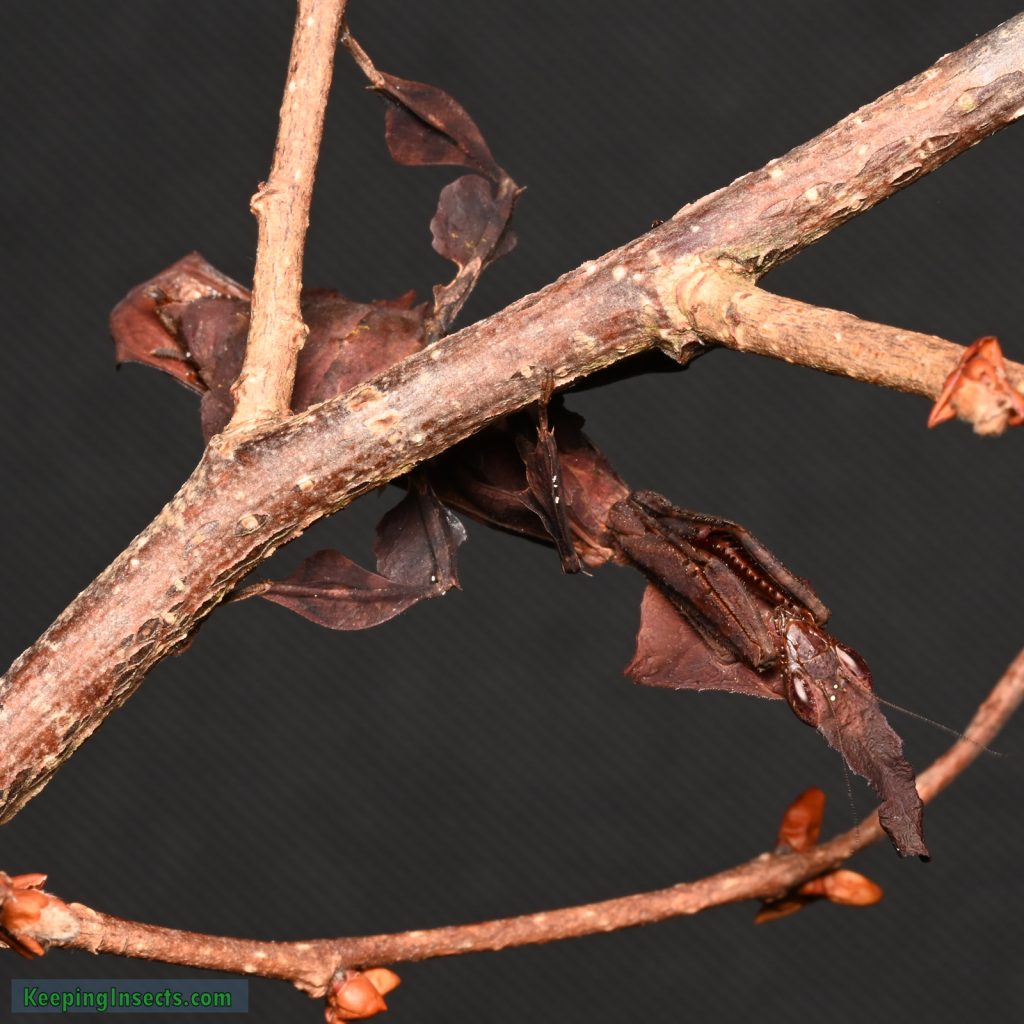
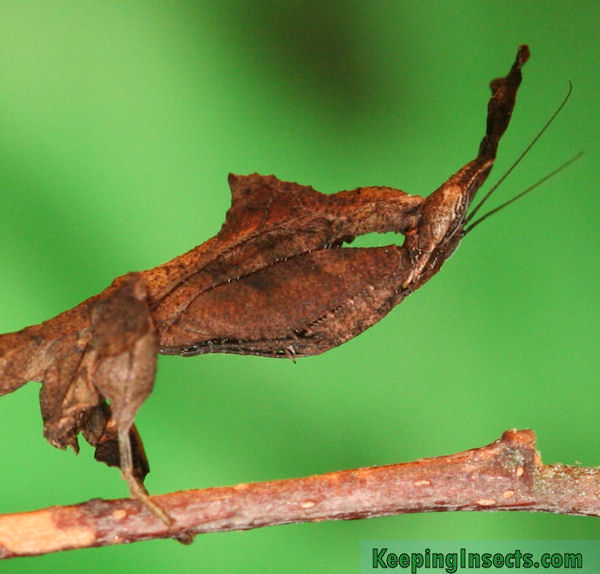
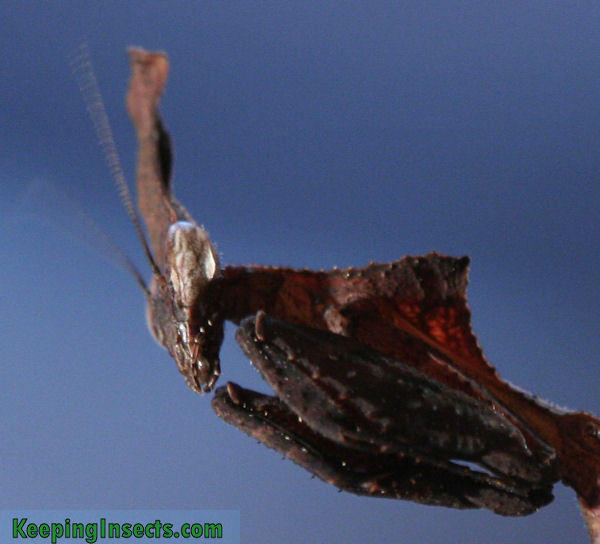
Environmental conditions for this mantis species
The ideal temperature for the Ghost mantis is around 26 °C, but a temperature between 20 °C and 30 °C is also okay. The temperatures can be allowed to drop at night, but should at least be 18 °C. You can read here more about heating the enclosure. This species prefers a relatively high air humidity. The RV (relative humidity) should be approximately 60 to 90%. This can be achieved by spraying with water about 5 times a week for the average enclosure.
The enclosure of this species of mantis should be at least 3 times the length of the animal in high, and at least 2x the length of the animal in width. For an adult this means is at least 15 cm in height and 10 cm in width. A nice size for a terrarium would be 20 x 20 x 30 cm, so there is space for lots of fake plants and perches. If you have a bigger terrarium you could also house multiple ghost mantises together, see below for more information on that.
Dead leaves in beautiful autumn colors as decorations in the terrarium fit the looks of this mantis perfectly. Sometimes they can hardly be spotted because of its perfect camouflage! If you want to try get green ghost mantises instead of brown ones, you could decorate the enclosure with more green plants and keep the enclosure more humid.
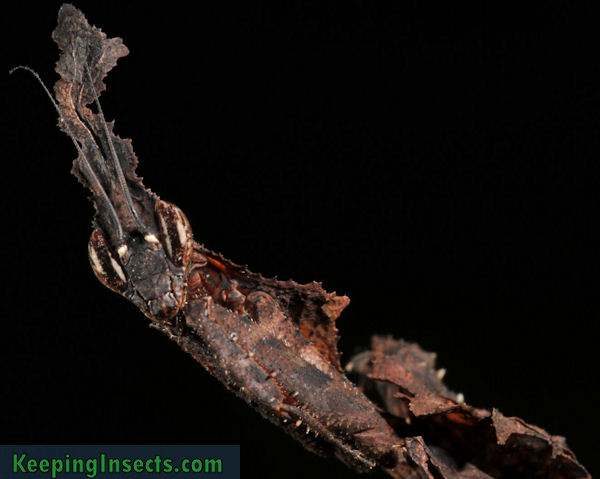
Group housing of Ghost Mantises
The special “feature” of this species of mantis is that multiple ghost mantises can be kept in one enclosure without cannibalism. Other mantis species will attack and eat each other, even it there is plenty of food. The Ghost mantis is often quiet and non-aggressive, also to other Ghost mantids, so it will tolerate it’s own kind.
Of course the mantis does need plenty of space and enough prey items such as flies, because when food is running low these mantids will also turn on each other. The individuals also need to be of the same size, you cannot combine animals that differ too much in instar. Keeping a large group of Ghost mantids in a big enclosure can be a beautiful sight. Keep in mind: the risk of cannibalism is very small, but the risk still exists.
Breeding Phyllocrania paradoxa
This species can be made to breed by most insect enthousiasts because it’s not a very difficult species to keep. You need to focus on good environmental conditions, then they will sort out the rest.
First you need to find a male and a female of around the same age. It’s easy to spot the differences in males and females, especially as they get older. The females of this species are slightly larger and broader than the males. Already in the older nymph instars you can see this difference. The sex difference can also be spotted when looking at the antennae; the base of the antennae of the male is wider and antennae are also longer in lenght. From around L4 (fourth instar) a keen eye can distinqish the sexes easily.
Approximately 2 to 4 weeks after the last molt, a mating attempt should be made. Make sure that the female is well fed before introducing the male. When you group house these mantids, you don’t need to do anything to ensure mating. The mantids will mate when the time is right, and usually you will not even see this happening because it is happens at night. Mating can take several hours and it only very rarely happens that the male will be cannabalized by the female.
The ootheca are long and sand colored and have between 20 and 60 eggs in them. They should be kept the same as the adult mantises. They hatch in around 6 to 8 weeks depending on the temperature. If the nymphs hatch but can’t escape the egg sack then you are keeping them too dry. Increase the air humidity for any next ootheca.
